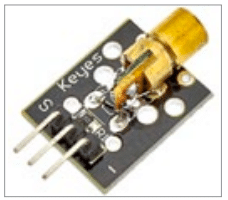There are various ways to interface a laser with Arduino depending on the application. A laser diode finds applications in CD/DVD reading and recording, optical-fibre communications, laser printing and scanning, laser pointers, directional lighting, barcode readers and so on. A laser diode can be interfaced with Arduino Uno using photoresistors, photodiodes, phototransistors or similar sensors and detectors.

Laser diodes and modules are available in various sizes and shapes. For example, a 3V to 5V DC, 5mW laser module is available in a metal case (Fig. 1). It produces a laser of about
650nm wavelength and a tiny red dot. It comes with three 1.5V button cells. Remove the cells and connect two wires: the positive wire to its body and the negative to the spring inside it. Connect the positive terminal to any one of the digital pins of Arduino board, and the negative wire to GND pin. Write a simple sketch (software) to turn on/off the laser torch through Arduino board.
Laser modules like KY-008 (Fig. 2) can also be connected directly to Arduino digital pins. This module can draw a current up to 30mA only, so it can be directly powered from an Arduino board.

You may refer to how to interface the KY-008 laser module with Arduino.
This link gives not only pin connection details but also Arduino code. You can also interface SF02 module directly with Arduino. SF02 is a lightweight laser rangefinder used for distance measurements ranging from 0 to 50 metres. Another interesting laser module from STMicroelectronics is VL53L0X. It works off 2.6-3.5V operating voltage and has I2C interface.
What are the different types of lasers available in the market?
Types of lasers
There are many types of lasers available for various applications. Depending on the lasing medium used, these are solid-state, gas, excimer, dye or semiconductor lasers.
• Solid state lasers emit infrared light at 1.064 micrometres.
• Gas lasers have a primary output of a visible red light. CO2 lasers emit energy in the far-infrared 10.6 micrometres, and are used for cutting hard materials.
• Excimer lasers produce light in the ultraviolet range.
• Dye lasers are tunable over a broad range of wavelengths.
• Semiconductor lasers are generally very small and use low power. These are used as the writing source in some laser printers, CD/ DVD players and the like.







